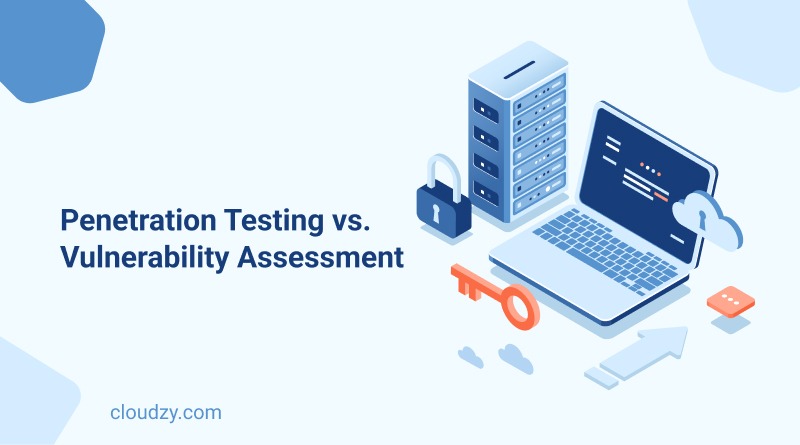Safeguarding your digital assets is a critical step to ensuring your organization’s security remains uncompromised. Thankfully, security measures to neutralize hackers’ schemes and threats are plentiful.
Choosing cybersecurity software heavily depends on the size of your business, goals, budget, and infrastructure. That being said, some software cybersecurity strategies have proven useful for most business types. Among which, VAPT testing solutions have gained a reputation for offering reliable, in-depth assessments that pinpoint vulnerabilities before attackers can exploit them.
Short for Vulnerability Assessment and Penetration Testing, VAPT testing platforms are powerful methods to ensure your cybersecurity posture remains as strong as possible. On one hand, vulnerability assessment tools allow you to identify security gaps across the board. On the other hand, you can take advantage of penetration testing (or pen testing) methods to simulate real-world attacks to see how well your defenses hold up under pressure.
VAPT Testing has different layers to it that can vary according to your company’s digital infrastructure. To choose the best combination of vulnerability assessment and penetration testing, it’s important to understand how each works and what benefits can be derived from them.
While similar in some ways, unique features set a pen test vs vulnerability test apart. In this post, I will explain everything you need to know about the difference between vulnerability assessment and penetration testing, their objectives, benefits, and applicable examples that better describe these cybersecurity solutions.
What Is Vulnerability Assessment?
The first half of VAPT testing revolves around vulnerability testing and assessment across different segments. A company’s digital infrastructure typically consists of several components that employees and teams use. Anything from on-premise endpoint devices and cloud systems to SaaS apps and online services that connect to your company’s network can be vulnerable to cybersecurity attacks and data breaches.

A vulnerability assessment includes a thorough evaluation of all of these components in order to provide organizations with a comprehensive understanding of their security posture to address vulnerabilities before attackers can exploit them. Fundamentally, this part of VAPT testing consists of four essential elements:
- Network-Based Scans: These scans zero in on potential security issues within network infrastructure components like routers, switches, and firewalls. They evaluate the vulnerability of the network’s overall design and setup.
- Host-Based Scans: This type of scan targets individual computing devices, such as desktop computers, servers, and other endpoints. It identifies vulnerabilities specific to the software and configurations present on these machines.
- Wireless Network Scans: These scans are dedicated to examining wireless networks, ensuring that the security of Wi-Fi connections is robust and safeguarded against exploitation by unauthorized entities.
- Application Scans: Focused on software and web applications, these scans are crucial for detecting vulnerabilities that could allow attackers to gain unauthorized access or manipulate sensitive data.
As mentioned, the first step of VAPT testing involves identifying and addressing vulnerabilities. When comparing vulnerability assessment vs penetration testing, these are some of the questions that you can find answers to when performing a vulnerability test:
- Which software versions or configurations are outdated or insecure?
- Are there open ports or exposed services that increase our risk?
- What sensitive data or assets are most likely to be targeted by attackers?
- How severe are the vulnerabilities identified, and which ones should we prioritize?
- What’s the potential impact if these vulnerabilities are exploited?
- Are there misconfigurations in our firewall, routers, or other network devices?
- Do our applications have security gaps that could lead to data breaches?
- How well are our security policies being followed across the organization?
- What steps can we take immediately to patch or mitigate these vulnerabilities?
What Is Penetration Testing?
Sometimes referred to as Pen Testing, the second half of VAPT testing is a technique to simulate cyberattacks on networks, systems, or applications to find potential security gaps that outsiders (or even insiders) could exploit. Think of it like hiring a “friendly hacker” to try and break into your setup before the real bad actors do. Unlike vulnerability assessments, which identify potential weak spots, pen testing goes a step further by actively testing those weak points to see if they can be exploited in real life.
In other words, while a vulnerability assessment tells you where you have gaps, a penetration test reveals if someone could actually slip through those gaps and cause damage. It’s more hands-on, often involving real-world attack scenarios to get a sense of how well your security holds up under pressure.
In VAPT testing, these are some of the issues penetration testing can help you address:
- Can an attacker actually exploit our identified vulnerabilities to gain unauthorized access?
- What specific paths or techniques could an attacker use to breach our defenses?
- How much damage could be done if an attacker gains access to our systems?
- How well do our current security measures, like firewalls and intrusion detection systems, hold up during an attack?
- Is there sensitive data that could be accessed or exfiltrated if someone got in?
- What level of access can be gained? Are there paths to escalate privileges once you are inside?
- How long does it take for our security team to detect and respond to a simulated attack?
- Could social engineering tactics, like phishing, be successful against our employees?
- What specific areas need strengthening to resist real-world attack scenarios?
Pen testing gives organizations a reality check on their defenses, showing exactly how an attacker might operate and what steps they can take to shore up security before a real attack happens.
Vulnerability Assessment vs Penetration Testing — Which One Is Right for You?
There is no doubt that all companies and organizations must put their cybersecurity and network safety first. By prioritizing these, companies must regularly conduct security assessments and ensure their systems and networks are bulletproof. The question here is not exactly which one of vulnerability assessment and penetration testing is best for my company; it’s more like how do I utilize VAPT testing to the best of my ability?
You can’t choose between network vulnerability assessment and penetration testing with a one-size-fits-all approach. You should take all the distinct needs of your organization into account. For example, you need to consider your organization’s primary objectives. Are you looking for a routine checkup of your security measures, like a regular health check? If so, a Vulnerability Assessment might be your choice.
In contrast, you might have rolled a new update and want to stress test your security layers. Or, your organization wants to determine how quickly and effectively the security team can detect and respond to a threat, offering insights beyond what a vulnerability assessment could provide. For such cases, opting for a pen test is a better strategy. This is where the difference between vulnerability assessment and penetration testing shows itself.
In short, the list below exhibits how VAPT Testing services can assist you:
Vulnerability Assessment
- Ideal for organizations that want a systematic and regular evaluation of their security posture.
- Suitable for compliance requirements, as many regulations mandate regular vulnerability assessments.
- Best for organizations with limited cybersecurity resources and budgets, as it typically requires fewer resources than penetration testing.
Penetration Testing
- Ideal for organizations looking to simulate real-world cyberattacks and assess their ability to survive threats.
- Useful when compliance requires a more comprehensive security assessment beyond vulnerability scanning.
- Beneficial for organizations with higher cybersecurity maturity and resources to address vulnerabilities promptly.
Regardless of which VAPT testing approach you go for, the goal remains the same: to strengthen your defenses, identify potential weaknesses, and ensure your systems are as resilient as possible against real-world threats.
Best VAPT Testing Solutions
In recent years, VAPT testing tools have evolved to cover various grounds and measure the strength of companies’ security layers. Given the complexity of tools and schemes attackers use to penetrate an organization’s network, it is of utmost importance to choose a vulnerability assessment and penetration testing tool that continuously updates its protocols to stand against every threat.
Below are three of the most credible VAPT testing solutions available on the market:
Nessus
Nessus also made our list of the best cybersecurity software solutions. As a vulnerability assessment tool, Nessus boasts a comprehensive scanning of different aspects of an infrastructure—from outdated software and misconfigurations to malware and network issues. Moreover, it offers a flexible platform with a user-friendly interface, making it an excellent choice for small businesses and large enterprises.
Cons:
- High licensing cost.
- Resource-intensive, slowing system operations during large scans.
OpenVAS
For those looking for an open-source VAPT testing tool, OpenVAS (Open Vulnerability Assessment System) can be an excellent choice. Thanks to its extensive database of network vulnerabilities and strong scanning features, OpenVAS works well across different security setups. Moreover, it gives you a lot of room for scalability and customization, making it an impressively versatile solution.
- Requires technical expertise for setup and configuration.
- Resource-intensive like Nessus.
Burp Suite
Last but not least, Burp Suite has gained a lot of popularity as a vulnerability testing tool for finding weaknesses in web applications. By performing comprehensive web vulnerability scanning, it helps companies ensure the risk of data breaches are minimized. Thanks to being highly configurable and coming with comprehensive documentation, it can be a perfect tool for advanced manual testing.
- Complicated setup for beginners.
- Expensive professional version, unsuitable for small businesses on a budget.
These are only some of the VAPT testing tools that predominantly focus on vulnerability assessment. Depending on your digital assets, company size, and budget, the right VAPT testing solution can differ. We published a dedicated informational post featuring professional insights and a more detailed list of the best vulnerability assessment and penetration testing solutions for businesses. Check it out for a more detailed comparative analysis.
Final Verdict: VAPT Testing Solutions Can Help You Minimize Vulnerabilities
VAPT testing combines vulnerability assessment and penetration testing, each serving distinct purposes. Vulnerability assessments identify weak spots in networks, systems, and applications, providing a high-level overview of potential risks. Penetration testing, however, actively exploits these weak points to uncover their real-world impact, focusing on complex issues that vulnerability scans might miss. While vulnerability assessments highlight risks, penetration tests demonstrate how attackers could exploit them, offering deeper insights into security gaps.
In terms of frequency and outcomes, vulnerability assessments are non-intrusive and suitable for regular use, akin to routine maintenance. Penetration tests are more intensive, conducted periodically or after major updates, functioning as stress tests for defenses. Vulnerability assessments produce reports of potential risks, while penetration tests offer actionable insights into exploitability. Combined through VAPT testing, these approaches provide a comprehensive view of security, balancing risk identification with practical testing.
Overall, VAPT testing tools can prove highly beneficial by thoroughly scanning your system and simulating real-life attacks to benchmark the strength of your security layers. Knowing the difference of pen test vs vulnerability test is vital for using your time and resources more effectively.
While both vulnerability assessment and penetration testing can be useful, not all organizations might need them. Choosing the right cybersecurity tool for the purpose at the right time can save you a lot of resources and ensure everything is secure without breaking the bank.
FAQ
Are vulnerability assessment and penetration testing solutions only relevant for large enterprises, or can small businesses benefit from them as well?
There are many vulnerability assessment and penetration testing tools on the market that offer a vast array of tools for different purposes. While some VAPT testing solutions focus on enterprise-level organizations, open-source platforms like OpenVAS can benefit companies of all sizes.
Can AI and automated VAPT testing tools replace the need for manual intervention in penetration testing and vulnerability assessment?
Automated tools can play a significant role in conducting vulnerability assessments and penetration testing, especially with the rise of AI. Based on The State of Pentesting Report 2024, 75% of pentesters state that their teams have adopted new AI tools in 2024. However, the most effective approach involves a balanced combination of automated tools and skilled human analysis.




